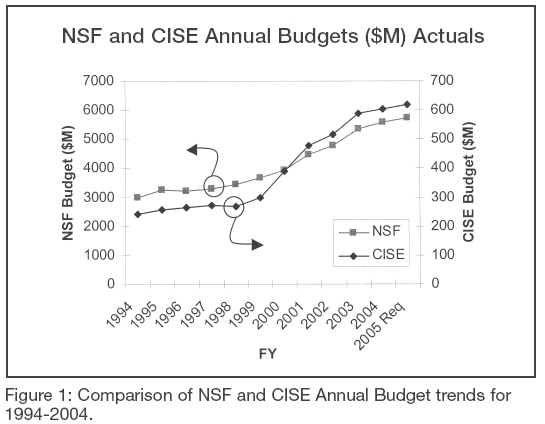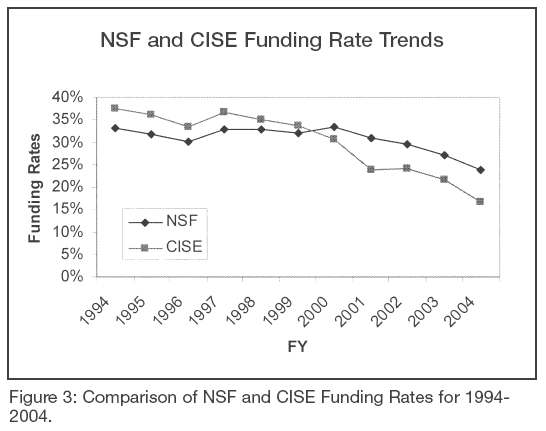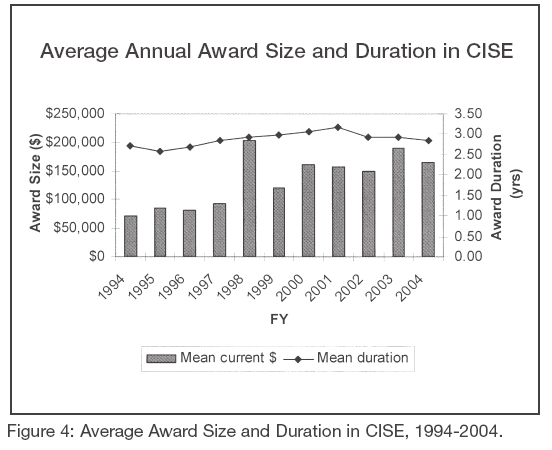THIS IS AN ARCHIVED VERSION OF CRA'S WEBSITE. THIS ARCHIVE IS AVAILABLE TO PROVIDE HISTORICAL CONTENT.
PLEASE VISIT HTTP://WWW.CRA.ORG FOR THE LATEST INFORMATION
| About CRA |
| Membership |
| CRA for Students |
| CRA for Faculty |
| CRA-Women |
| Computing Community Consortium (CCC) |
| Awards |
| Projects |
| Events |
| Jobs |
| Government Affairs |
| Computing Research Policy Blog |
| Publications |
| Data & Resources |
| CRA Bulletin |
| What's New |
| Contact |
| Home |
<< Back to November 2004 CRN Table of Contents
[Published originally in the November 2004 edition of Computing Research News, Vol. 16/No. 5]
CISE 1994-2004: A Decade in Review
By Peter A. Freeman and Lee Harle
Computing faculty who have recently submitted proposals to CISE have come to understand the increasing demands on CISE’s budget. While there has been considerable growth in the budget in recent years, this growth has not kept pace with the escalating number of promising research and education opportunities and challenges in our field. Consequently, proposal success rates in CISE are dropping to new lows. Like you, we are concerned about this. This article seeks to shed some light on CISE budget and funding trends, and a companion article on page 4, “CISE Update: Adjusting to the Increase in Proposals,” describes CISE’s current plan to adapt in this changing environment.
The CISE budget has grown significantly in the last decade, but most markedly over the past five years as can be seen in Figure 1. A significant change in growth rate can be observed in the 1999-2000 period. Why? In February 1999, the President’s Information Technology Advisory Committee (PITAC) published a report that asserted that “Federal support for research in information technology is seriously inadequate.” In response to PITAC recommendations, NSF deemed Information Technology Research (ITR) a budget priority area and, indeed, Networking and Information Technology Research and Development (NITRD) became a government-wide priority. And more dramatic increases in the CISE budget ensued. Figure 1 describes CISE budget growth over the 1994-2004 period and demonstrates that growth in CISE funding exceeded growth in NSF overall.

Over this same time period, the number of CS and CE faculty nationally has also been rising, with CRA’s Taulbee Survey indicating a greater than 35 percent increase from 1998 to 2003 in tenure-track faculty in Ph.D.-granting CS and CE departments. This increase in the number of computing faculty can be attributed to the movement of researchers to academia following the closing or downsizing of industrial labs, and to the growing number of new Ph.D.s accepting tenure-track positions in Ph.D.-granting departments in recent years.
The growing number of CS and CE faculty, coupled with NSF’s annual solicitations for ITR proposals (2000-04), resulted in a significant increase in the number of proposals submitted to CISE. This growth in what we call ‘proposal pressure’ should not, however, be attributed only to the growing number of faculty and our ITR competitions. In fact, it is also associated with the expanding mission of our field and the associated increase in emerging research and education opportunities. Undoubtedly, there is growing recognition of the promise of computing research contributions in society, and as part of that, the expanding role of computing in science and engineering research and education in general (e.g., in science and engineering informatics).
Figure 2 compares the number of proposals received and reviewed by CISE and the number of proposals awarded, and it presents the funding rates calculated from these data over the 1994-2004 period. In 1998, CISE received a total of 2,044 competitive proposals. By 2004, this number had risen to 6,222. Figures 1 and 2 clearly indicate that while the CISE budget more than doubled between 1994 and 2004, the number of proposals received on an annual basis has more than tripled during this ten-year time period. Over the same period, the funding rate for proposals submitted to CISE has dropped considerably, from approximately 36 percent in 1994 to a decadal low of 16 percent in 2004.

While in the early part of the last decade CISE funding rates were higher than NSF’s overall funding rate, more recently CISE funding rates have dropped below the overall rate by quite a significant margin, even while the CISE budget was growing at a faster rate, as demonstrated in Figure 3.

Funding rates within CISE programs vary. However, direct comparisons across programs cannot readily be made due to different funding histories and proposal solicitation strategies. For example, some programs carry significant mortgage obligations, upwards of 60 percent of their annual budget, due to awards recommended for funding in previous years. Some programs impose restrictions on the number of proposals a PI can submit while others do not, which of course modulates funding rate data. Yet others are new programs that may be either oversubscribed or undersubscribed at their inceptions before reaching relatively steady-state conditions. What is clear, though, is that funding rates for CISE as a whole have halved in a decade.
Also contributing to the decline in funding rates is the desire to increase average grant size. As indicated in Figure 4, although award duration has remained relatively constant over the ten-year period, the average grant size has risen steadily—from an annual level of $72,000 in 1994 to an annual level of $165,000 in 2004. This growth in average grant size is consistent with NSF’s goals and is responsive to PITAC’s recommendations.

We think you can see that a combination of a number of factors—increasing numbers of proposals, an increased number of awards, increasing average annual award amounts, and budget growth that has not kept pace with demand—has resulted in significantly reduced proposal funding rates.
The companion article, “CISE Update: Adjusting to the Increase in Proposals,” describes CISE’s current plan to adapt to this changing environment. However, as we make and implement these plans, the community must also think about its funding needs, priorities, and strategies. With computing advances increasingly important to advances in other science and engineering fields, computing faculty must continue to explore funding opportunities from all sources, including CISE and other organizations within NSF. Moreover, the computing research and education community needs to speak with one voice about the critical contributions that they can, and indeed must, be empowered to make towards creating a safe, healthy and vibrant civil society, both in the United States and around the world.
Peter Freeman (pfreeman [at] nsf.gov) is the Assistant Director of Computer and Information Science and Engineering at the National Science Foundation. Lee Harle is an NSF AAAS Fellow.
Copyright © 2007 Computing Research Association. All Rights Reserved. Questions? E-mail: webmaster@cra.org.
